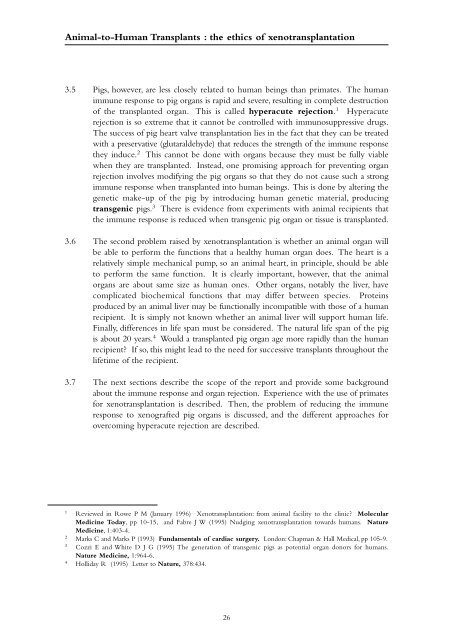Xenotransplantation - Nuffield Council on Bioethics
Xenotransplantation - Nuffield Council on Bioethics
Xenotransplantation - Nuffield Council on Bioethics
Create successful ePaper yourself
Turn your PDF publications into a flip-book with our unique Google optimized e-Paper software.
Animal-to-Human Transplants : the ethics of xenotransplantati<strong>on</strong><br />
3.5 Pigs, however, are less closely related to human beings than primates. The human<br />
immune resp<strong>on</strong>se to pig organs is rapid and severe, resulting in complete destructi<strong>on</strong><br />
of the transplanted organ. This is called hyperacute rejecti<strong>on</strong>. 1 Hyperacute<br />
rejecti<strong>on</strong> is so extreme that it cannot be c<strong>on</strong>trolled with immunosuppressive drugs.<br />
The success of pig heart valve transplantati<strong>on</strong> lies in the fact that they can be treated<br />
with a preservative (glutaraldehyde) that reduces the strength of the immune resp<strong>on</strong>se<br />
they induce. 2 This cannot be d<strong>on</strong>e with organs because they must be fully viable<br />
when they are transplanted. Instead, <strong>on</strong>e promising approach for preventing organ<br />
rejecti<strong>on</strong> involves modifying the pig organs so that they do not cause such a str<strong>on</strong>g<br />
immune resp<strong>on</strong>se when transplanted into human beings. This is d<strong>on</strong>e by altering the<br />
genetic make-up of the pig by introducing human genetic material, producing<br />
transgenic pigs. 3 There is evidence from experiments with animal recipients that<br />
the immune resp<strong>on</strong>se is reduced when transgenic pig organ or tissue is transplanted.<br />
3.6 The sec<strong>on</strong>d problem raised by xenotransplantati<strong>on</strong> is whether an animal organ will<br />
be able to perform the functi<strong>on</strong>s that a healthy human organ does. The heart is a<br />
relatively simple mechanical pump, so an animal heart, in principle, should be able<br />
to perform the same functi<strong>on</strong>. It is clearly important, however, that the animal<br />
organs are about same size as human <strong>on</strong>es. Other organs, notably the liver, have<br />
complicated biochemical functi<strong>on</strong>s that may differ between species. Proteins<br />
produced by an animal liver may be functi<strong>on</strong>ally incompatible with those of a human<br />
recipient. It is simply not known whether an animal liver will support human life.<br />
Finally, differences in life span must be c<strong>on</strong>sidered. The natural life span of the pig<br />
is about 20 years. 4 Would a transplanted pig organ age more rapidly than the human<br />
recipient? If so, this might lead to the need for successive transplants throughout the<br />
lifetime of the recipient.<br />
3.7 The next secti<strong>on</strong>s describe the scope of the report and provide some background<br />
about the immune resp<strong>on</strong>se and organ rejecti<strong>on</strong>. Experience with the use of primates<br />
for xenotransplantati<strong>on</strong> is described. Then, the problem of reducing the immune<br />
resp<strong>on</strong>se to xenografted pig organs is discussed, and the different approaches for<br />
overcoming hyperacute rejecti<strong>on</strong> are described.<br />
1<br />
Reviewed in Rowe P M (January 1996) <str<strong>on</strong>g>Xenotransplantati<strong>on</strong></str<strong>on</strong>g>: from animal facility to the clinic? Molecular<br />
Medicine Today, pp 10-15, and Fabre J W (1995) Nudging xenotransplantati<strong>on</strong> towards humans. Nature<br />
Medicine, 1:403-4.<br />
2<br />
Marks C and Marks P (1993) Fundamentals of cardiac surgery. L<strong>on</strong>d<strong>on</strong>: Chapman & Hall Medical, pp 105-9.<br />
3<br />
Cozzi E and White D J G (1995) The generati<strong>on</strong> of transgenic pigs as potential organ d<strong>on</strong>ors for humans.<br />
Nature Medicine, 1:964-6.<br />
4<br />
Holliday R (1995) Letter to Nature, 378:434.<br />
26
















